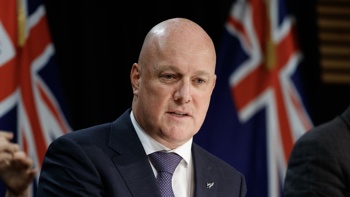Auckland will stay at level 3 with existing restrictions for the next two weeks at least, Prime Minister Jacinda Ardern says.
She could not say exactly how long Auckland would be at level 3 before restrictions eased further.
In Northland, the evidence suggested Covid-19 had not been spread further. It will move to level 2 at 11.59pm on Tuesday 19 October.
In Waikato, the cases were broadly linked but she said further cases and wastewater testing meant it should be held at level three for now.
That would be reviewed this Friday.
Ardern today said the rest of New Zealand will remain at level 2.
Auckland's restrictions allow people to visit friends and families outside, as long as they remain socially distanced, limit their gatherings to two household bubbles and keep to groups of 10 people or fewer.
The path out of lockdown
Ardern said in the future she could not ask people to live week by week without knowing what restrictions they would face. On Friday, she would set out the new system for dealing with Covid-19.
The new framework would include a vaccination target before it came into effect, and that would be based on international experience.
The vaccination target would be very high, she said.
Ardern said the future framework would include vaccination passes.
Ardern says Super Saturday's 130,000 vax result was extraordinary and thanked all of those who took in it. "It reminded us all we are still a team, if we have a job to do we will rally to do it."
Director general of health Ashley Bloomfield said the campaign to get vaccination rates up had been effective. He said 90 per cent was a "milestone" but "we do not intend to stop there."
Bloomfield said they hoped Auckland to soon hit the 90 per cent milestone for first doses. The double dose levels would follow about a month after that.
It was hard to predict at which point it would top out, given most vaccinations were now walk-ins rather than booked.
Asked if the government would provide other vaccines for those who did not want Pfizer, Bloomfield said advice was still being worked through on an alternative for those who refused the mRNA vaccines.
Ardern said work was underway to ensure those vaccinated overseas could have that recognised here.
On vaccinations for 5-11 year olds, Bloomfield said he was still waiting for more information from Pfizer on that.
On iwi leaders rejecting the traffic lights framework proposal, Ardern said whilst they were sharing some details of the framework, they were yet to finalise the plans and once that happened it could assuage some concerns.
She said the emphasis was still on keeping people safe from Covid. However, with a highly vaccinated population things could be done differently.
On MIQ stays, Ardern said shorter stays and home isolation were part of a future plan. However, it would happen only when safe to do so.
"This outbreak has forced us to bring forward some of the plans we had made. But we don't want to seed new cases in the community when we are continuing to control the outbreak in Tāmaki Makaurau."
She said the Government was considering the MIQ issue now, but no decisions were ready to be announced.
Why PM didn't put Auckland into level 4
The Prime Minister said restrictions in Auckland had made a difference and vaccinations were still critical.
However, restrictions and vaccinations were still needed. That made it easier to keep control of Covid-19.
Cabinet wrestled with avoiding a spike in the coming weeks while vaccination levels rose.
Ardern said the alert level 3 rules were the toughest rules in place anywhere. She said experts had recommended a return to level 4 for a couple of weeks, but the public health advice was that two more weeks at level 4 was unlikely to reduce cases significantly because of the nature of the outbreak and compliance.
Ardern said that latter advice was critical.
Asked about the calls for a "circuit breaker" return to level 4, Ardern said she had always listened to advice from a range of experts and the public health experts on the ground.
"The advice was that level 4 would not necessarily make a difference to the number of cases in this outbreak... however, level 3, if followed, would make a difference and will continue to make a difference. But we need ongoing compliance."
Asked what the advice was on the difference level 4 would have made compared to staying with level 3, Ardern said an R value closer to 1 meant it would be easier to maintain low cases.
The R value had come down a bit after reaching 1.3 and 1.4, to between 1.2 and 1.3. Ardern said modelling the difference between level 4 and 3 was difficult because it was difficult to model compliance.
Bloomfield said it was a judgment call, rather than one of modelling, given the consideration that had to be given to compliance difficulties.
Ardern asked people to comply with those restrictions, especially the ban on indoor gatherings.
There were now cases in 124 suburbs - all across Auckland - and that meant anyone was at risk of getting Covid-19, no matter what suburb they lived in.
"We ask you be masked, and distanced, with no more than 10 people from two households."
"Indoor gatherings, parties, they're not part of level 3."
Asked about widespread breaches of the rules, Ardern said that households mixing indoors or in large gatherings was one of the contributors to the outbreak.
"We don't just make them up [the restrictions] they are based on advice from public health."
Asked if there were any cases amongst those who went to the protest on Saturday, Ardern said she had not had that reported as yet. Bloomfield said "our great hope is there aren't" however he urged anybody who went to a protest and had symptoms to get tested.
Ardern said the health workers on the ground had identified that the virus was spreading by people meeting indoors.
Ardern said there was a sense that people thought the outbreak was isolated to certain suburbs of Auckland. "And that is not true. Noone should think they can act differently just because they are in a part of Auckland that didn't have a case."
Ardern said there had been a long period of time of restrictions. In Australia, there had been a "tipping point" after a long period of restrictions, and that was when cases started to rise. She said rather than wait for that here, and the risk that people would meet indoors to try not to get caught, the Government had moved to give Aucklanders a "safe" way of gathering outside to try to prevent the same thing happening.
Finance Minister Grant Robertson was working on more business support packages and would set that out on Friday.
On support for low-income households. Ardern said she had signalled that was coming and a date for announcing it would be set soon. She said that would be quite targeted.
On Tairawhiti crowd-funding a mobile vax bus rather than having access to vaccinations rollout funding, Ardern said the Government had tried to cut through the barriers that Maori health providers were facing. They had committed to changing the way they dealt with funding and Peeni Henare had gone out on the road to assess it. Ardern said she had seen the Give A Little page for Tairawhiti. "Not one region in this country should have to rely on crowd-funding to support a vaccination effort. There is no need to fundraise, it's just a matter of getting the money in the right place."
Public health experts, as well as calling for a level 4 move to be considered, have also cautioned against moving Auckland to step 2 of level 3 restrictions, which would see more customer-facing businesses reopen, including retail, libraries, and museums - with restrictions including mask-wearing.
The outbreak in Auckland has now spread throughout the city and case numbers are expected to grow, potentially 160 cases a day by early November.
There were 60 cases reported in today's update, including three in Waikato - two of which are unlinked.
That brings the total number of unlinked cases in Waikato to six. In total, including Auckland, there are 140 unlinked cases in the past fortnight.
One of the new cases is a staff member at Remuera Gardens retirement village in Auckland, but the risk is considered low as staff and residents there have high vaccination rates.
Level 2 for Northland looks more likely, given there have been no cases there since the region moved to level 3 10 days ago.
Three women who travelled from Auckland to Northland and back have all tested positive, but none of the testing in the region - including wastewater testing - has indicated any other cases.
Super Saturday has helped push vaccination rates in Auckland to 89 per cent of eligible people with one dose and 71 per cent with two doses, prompting Bloomfield to say Auckland could hit 90 per cent fully vaccinated within four weeks.
Nationwide, 85 per cent of eligible people have had one dose and 66 per cent have had two doses, though the numbers are much lower for Māori (66 per cent and 45 per cent).
Māori make up most of the active cases in the Auckland outbreak.
There are still about 2.3 million people in New Zealand who are not fully vaccinated, including about 750,000 children under 12. In Auckland, there are just under 1 million people - including children - who are not fully vaccinated.
Of the 2005 cases in the outbreak so far, 409 of them are not eligible to be vaccinated because they are younger than 12.
Of the remaining 1596 cases, 1132 cases (71 per cent) were unvaccinated and 91 cases (6 per cent) were fully immunised, meaning they had two doses and at least two weeks since the second dose when they tested positive.
Of the 179 cases that have needed hospital care, seven children were not eligible for the vaccine.
Of the remaining 172 cases, 138 cases (80 per cent) were unvaccinated, and three (1.7 per cent) were fully immunised.
Take your Radio, Podcasts and Music with you









